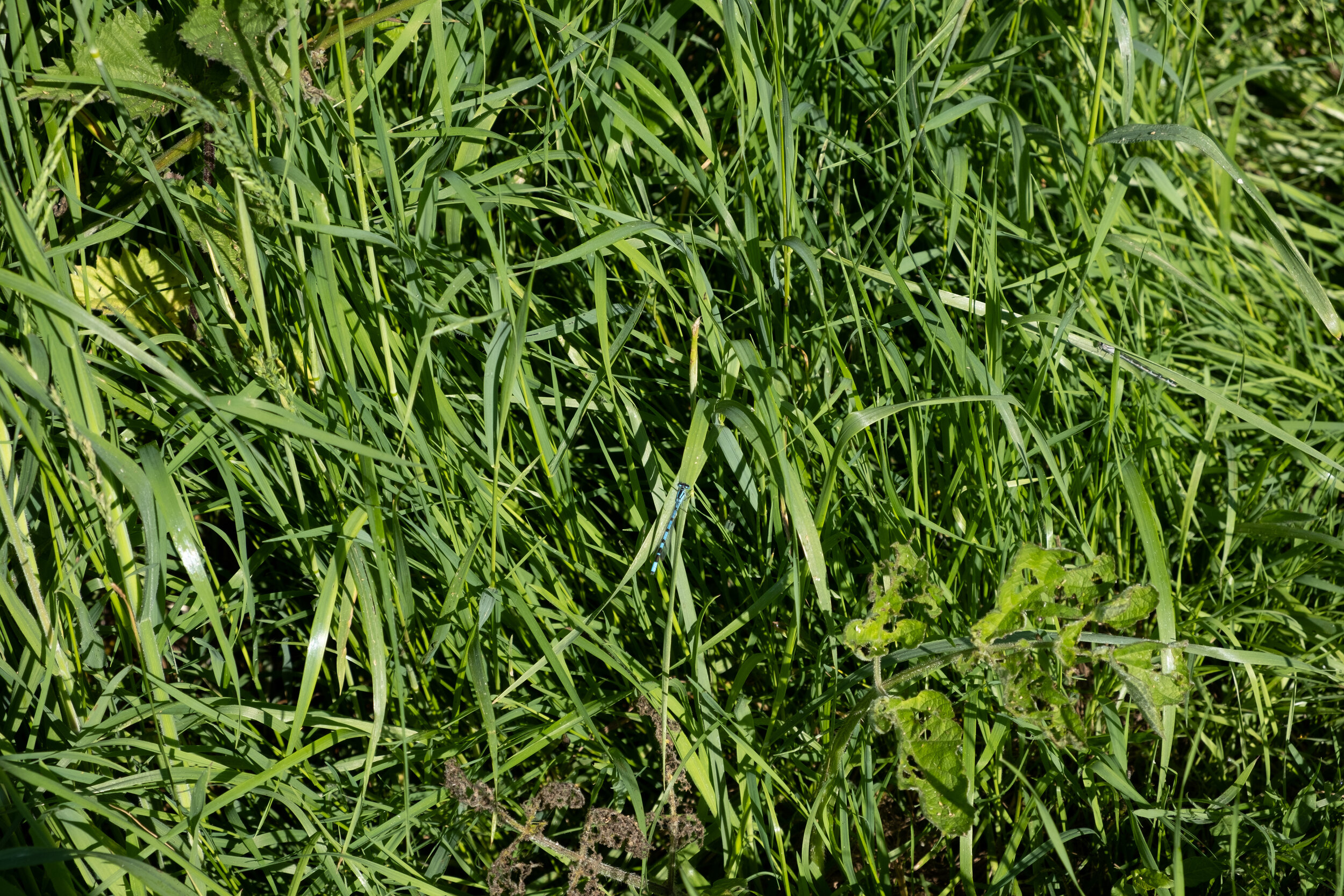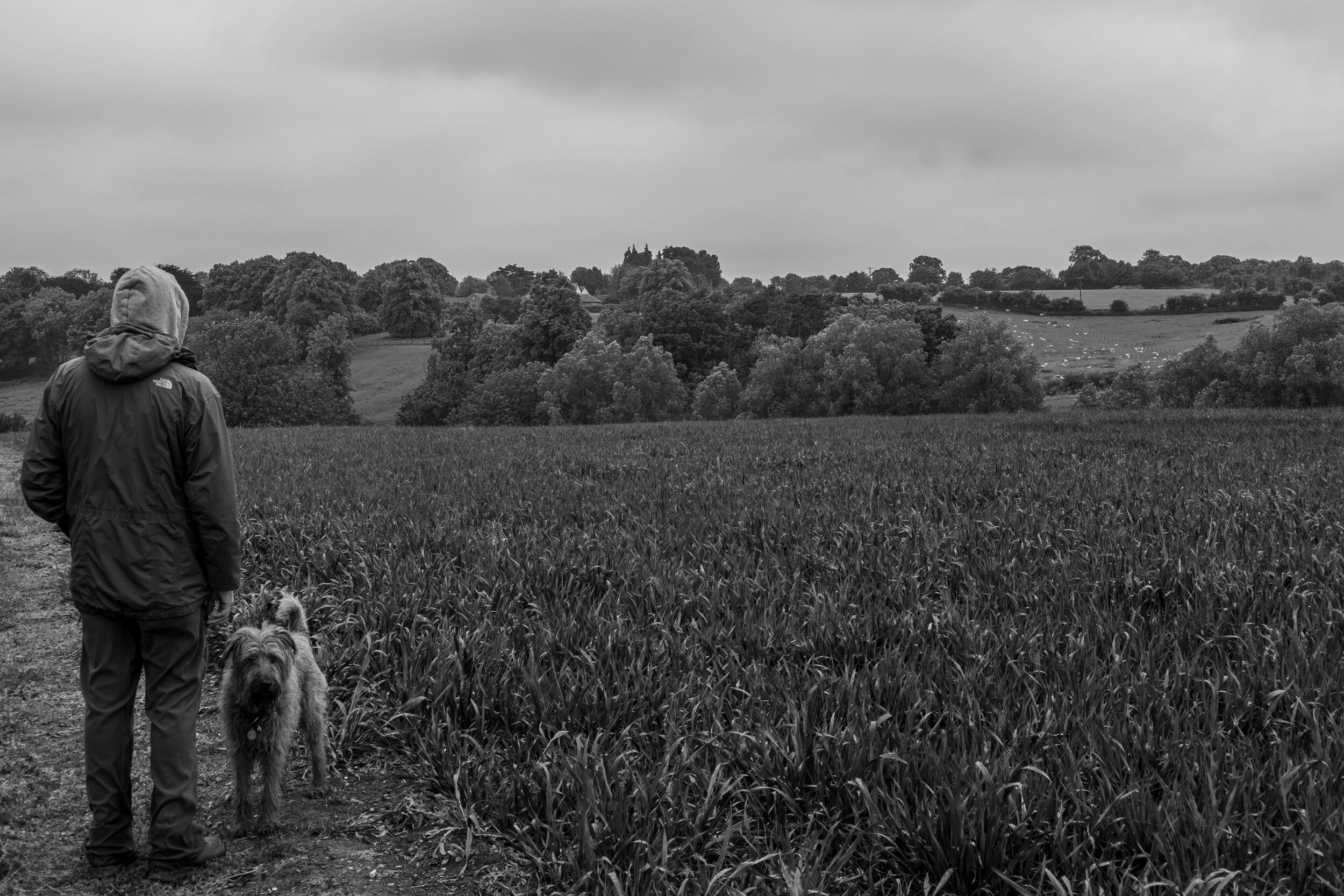Myfield in June
A month of great growth and rapid transition
June turned out to be a month of great growth and rapid transition. Over the first two weeks, the weather picked up considerably and by the second week we saw temperatures averaging around 19/20 with localised highs possibly over 25 degrees.
The cow parsley, so long the main flowers around the periphery of Myfield, were now beginning to fade. The hogweed towered over its cousin but they were nowhere near their predecessors in numbers. A few more flowers put in an appearance around the margins though numbers remain slim. The wooded area on the eastern edge still sported a fine covering of cow parsley giving the light under the new canopy a glorious lime tinge. Under the trees on the northern boundary, a wider variety of plants were beginning to show through, noticeably, due to its size, the dog rose buds suggesting both white and pink varieties to come. There were also some large wild bramble flowers.
Common Blue damselfly…searching for a green blade or leaf that would help disguise their presence.
The thing that caught my eye most of my walk on the second weekend were the sheer number of damselflies, in this case they Common Blue Damselfly (Common Bluet). They vary from mature males of vibrant electric blue to immature ‘drab’ females. They hover with a sort of backward/forward stutter and then either set off or usually try to find a blade of grass or a leaf to rest on. If the are newly emerged they will be waiting for their wings to dry before setting off in search of food and a mate. It was interesting to note that they all shunned the buttercups, which I thought would make a great photograph, instead searching for a green blade or leaf that would help disguise their presence.
The elusive Beautiful Desmoiselle still tantalised me. A young female flitted just out of distance for the camera eventually settling on a tree, her toffee-coloured wings protruding above the leaves, five metres or so over my head.
…somewhat different to those clod bare days of winter
The track down to the clay pit looks somewhat different to those cold bare days of winter. The ruts are dry, the hedges decorated with the last of the may blossom and a layer of cow parsley. Hiding away are the buds of honeysuckle and elderflower, both reluctant to come out too early on this north-facing edge through on the sunny side the elderflower is coming out in all its frothy glory and the scented honeysuckle is in flower further up the track in a more sheltered patch.
The buttercups are at their height in this first half of the month. They stayed around for some time but the biggest display occurred along the east facing edge that gets the sun this time of year through to late afternoon. Often augmented by various insects, one of my favourites is the iridescent green bug, the Thick-Legged or Fat-Legged Beetle, Oedemera nobilis, also known as the False Oil Beetle.
…a natural spring ritual
A week later and the the dog roses are fully out, their bushes in the borders of the lines of trees, their pink or white flowers shining out, a pleasure to see at head height after all that looking at the ground to see what is in flower. The bramble in the copse was in flower, promises of juicy fruit to come. In places they made a break for it, leaving the ever-darkening canopy and serpenting out into the open under the cover of the long grass. Nearby, on a young oak, its fresh green leaves soaking up the warmth, a pair of crane flies joined together in a natural spring ritual.
Cuckoo spit
About this time, Cuckoo Spit put in an appearance, globules of foamy substance around the stems of the grasses. Unfortunately, in a way, it is not the spit of a cuckoo, though it does conjure up an interesting image. It is a foamy protection for the nymph of the froghopper, a small insect common across the UK and is related to, albeit distantly, to aphids and cicadas.
But oh how fickle these summers are. Soon flaming June had become flaming June as the temperatures dropped and at times we were lucky to see - or feel - anything above 15 degrees. It did make going in search of the interesting and the new in Myfield quite a challenge. Days went by when the butterflies and the damselflies stayed in the warmth of their hiding place.
A Red Admiral hides on the bark of a tree…
A Red Admiral butterfly hides on the bark of a tree, the yellow of the lichen a good foil for the bark-effect of the butterfly’s underwings. Meadow browns are beginning to make an appearance so now we know that Summer is truly here and soon the speckled woods and the ringlets should be joining them along these margins and particularly along Green Lane.
By the 19th the edges have been mown but this year they are not cropped right back to the edge so there is still a good margins between headland and hedge. The bird feed crop starts to show through.
The next day the sky - and I - had changed. It was overcast, oppressive. The light was grey and flat and there was no hope of anything to brighten my day. Armed this time with tripod and needing some serious time in the open air, I was unsure as to whether this would recharge my batteries or short me out. The first image I took, a landscape, is dark, indistinct and in black and white. My thinking was that there would be no clarity in the colours so shoot monochrome. It also suited my mood. The best I could get was a view across the clay pit but it was also a bit of a self-portrait, except the dog was probably the one facing the right way.
The light was grey and flat and there was no hope of anything to brighten my day.
Two days later, the weather had improved as had my mood and just to prove it, a speckled wood lay itself out for me. Green Lane was particularly lush despite the motorbike traffic. In the field on the other side, posts were being put in to fence the field. It looks like it is to move from arable to sheep. We shall see. Small Tortoiseshells are regularly putting in an appearance though not in good numbers.
On the 24th, mushrooms popped up along the eastern side. By now the grasses had fine full heads of seed and bowed gently and nodded in the breeze. Some of the roses were impossibly white, some blushed pink further in the wood. Bees pollinated the blackberries whilst others twined themselves amongst the pine needles on the Scots pines, collecting honeydew. A beetle with preposterously long antennae switched atop a nettle.
…preposterously log antennae…
The month ended with the proverbial whimper. Dull, overcast, misty. The greens soon became greys as you looked into the distance which in turn dissolved into the liminal space that was neither land nor sky, yet both.
…dissolved into the liminal space that was neither land nor sky, yet both








